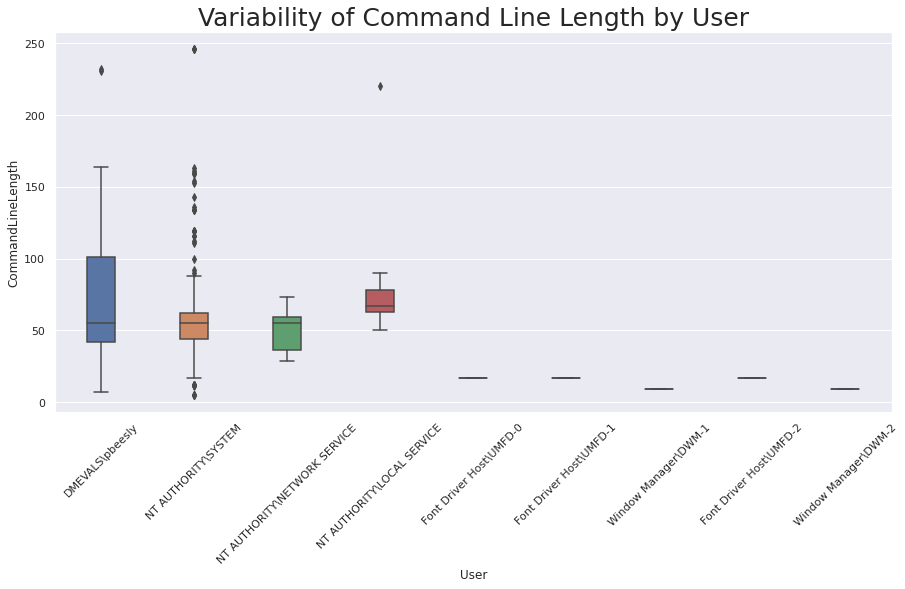Data Analysis with Spark.SQL: Visualizing¶
Author: Jose Rodriguez (@Cyb3rPandah)
Project: Infosec Jupyter Book
Public Organization: Open Threat Research
License: Creative Commons Attribution-ShareAlike 4.0 International
Reference: https://spark.apache.org/docs/latest/api/python/pyspark.sql.html
Creating SQL view from Mordor APT29 dataset¶
Create Spark session¶
from pyspark.sql import SparkSession
spark = SparkSession \
.builder \
.appName("Spark_Data_Analysis") \
.config("spark.sql.caseSensitive","True") \
.getOrCreate()
Expose the dataframe as a SQL view¶
apt29Json = '../datasets/apt29_evals_day1_manual_2020-05-01225525.json'
apt29Df = spark.read.json(apt29Json)
apt29Df.createOrReplaceTempView('apt29')
Visualizing data¶
Get most frecuent Destination IPs in Network Connection events (More than 10 connections)¶
Create dataframe
networkConnections = spark.sql(
'''
SELECT DestinationIp, count(*) as Frequency
FROM apt29
WHERE lower(Channel) LIKE '%sysmon%'
AND EventID = 3
GROUP BY DestinationIp
HAVING Frequency > 10
ORDER BY Frequency DESC
''')
print('This dataframe has {} records!!'.format(networkConnections.count()))
networkConnections.show()
This dataframe has 8 records!!
+--------------------+---------+
| DestinationIp|Frequency|
+--------------------+---------+
| 192.168.0.4| 356|
| 10.0.0.4| 323|
|fe80:0:0:0:e40c:9...| 116|
| 0:0:0:0:0:0:0:1| 111|
| 10.0.1.4| 75|
| 10.0.1.6| 62|
| 172.18.39.2| 30|
| 10.0.1.5| 21|
+--------------------+---------+
Create Vertical bar chart
from bokeh.io import output_notebook, show
from bokeh.plotting import figure
from bokeh.models import ColumnDataSource, LabelSet
from math import pi
# Source of Data
source = ColumnDataSource(networkConnections.toPandas())
# List of values for X axis
destinationIps = source.data['DestinationIp'].tolist()
# Figure object
p = figure(x_range = destinationIps,
title="Frequency of Network Connections by Destination IPs")
# Vertical Chart
p.vbar(x = 'DestinationIp', top = 'Frequency', source = source, width = 0.7)
# Title Format
p.title.text_font = "arial"
p.title.text_font_size = "20px"
p.title.align = "center"
# X-axis format
p.xaxis.major_label_orientation = pi/2
# Data labels
labels = LabelSet(x = 'DestinationIp', y = 'Frequency', text = 'Frequency', level = 'glyph',
x_offset = -10, y_offset = 0, source = source, text_font = 'arial', text_font_size = '15px')
p.add_layout(labels)
# Figure presentation
show(p)
Represent variability of Command Line Length in Process creation events by User using a Box Plot¶
Create dataframe
commandLineLength = spark.sql(
'''
SELECT User, length(CommandLine) as CommandLineLength
FROM apt29
WHERE lower(Channel) LIKE '%sysmon%'
AND EventID = 1
AND length(CommandLine) < 300
''')
print('This dataframe has {} records!!'.format(commandLineLength.count()))
commandLineLength.show(n = 5)
This dataframe has 439 records!!
+-------------------+-----------------+
| User|CommandLineLength|
+-------------------+-----------------+
| DMEVALS\pbeesly| 43|
| DMEVALS\pbeesly| 99|
| DMEVALS\pbeesly| 29|
| DMEVALS\pbeesly| 10|
|NT AUTHORITY\SYSTEM| 66|
+-------------------+-----------------+
only showing top 5 rows
Create a Box Plot chart
import seaborn as sns
sns.set(style="whitegrid")
sns.set(rc={'figure.figsize':(15,7)})
# Source of Data
source = commandLineLength.toPandas()
# seaborn object
boxPlotChart = sns.boxplot(x = 'User', y = 'CommandLineLength', data = source, orient = 'v',width = 0.3)
# Title format
boxPlotChart.set_title("Variability of Command Line Length by User", fontsize = 25)
# X-axis format
boxPlotChart.set_xticklabels(boxPlotChart.get_xticklabels(), rotation=45);

